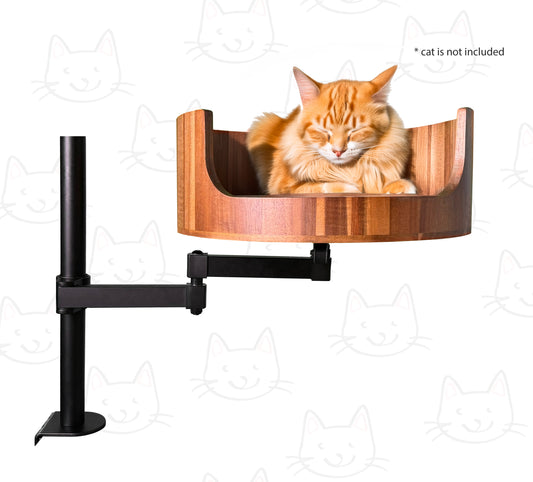
Why Do Cats Chase Their Tails? Exploring Feline Behavior
Share
Have you ever noticed your cat chasing its tail around in circles and wondered why they do this? This common feline behavior has been a puzzling phenomenon for cat owners everywhere. In this article, we will delve into the reasons behind why cats chase their tails, exploring the potential motivations and instincts that drive this quirky behavior.
From domestic house cats to wild felines, tail chasing is a behavior exhibited across different species of cats. Interestingly, this behavior is not just limited to kittens but can also be observed in adult cats. While tail chasing may seem like a playful activity, it can also be a sign of underlying issues such as boredom, pent-up energy, or even neurological disorders. By understanding the reasons behind this behavior, cat owners can better cater to their feline companions' needs and provide appropriate outlets for their natural instincts. Let's uncover the fascinating world of cat behavior and unravel the mystery behind why cats chase their tails.
1. Cats may chase their tails out of boredom, curiosity, or as a form of play.
2. Tail-chasing behavior in cats can also be a way to release excess energy or relieve stress.
3. In some cases, tail-chasing could indicate an underlying medical issue, so it's important to monitor this behavior closely.
4. Kittens are more likely to exhibit tail-chasing behavior as they are still in the exploratory stages of development.
5. Providing interactive toys, engaging playtime, and a stimulating environment can help reduce tail-chasing tendencies in cats.
## Evolutionary Instincts in Cats
Cats chasing their tails may simply be a result of instinct passed down from their wild ancestors. In the wild, kittens often engage in play behaviors that mimic hunting and fighting, and chasing their tails could be a way for domesticated cats to exercise these natural instincts. Cats may also chase their tails as a way to alleviate boredom or excess energy, much like how they would engage in hunting or play behavior in the wild.
## Medical Reasons for Tail Chasing
While tail chasing is often harmless, it could also be a sign of underlying medical issues in some cases. Cats may chase their tails if they are experiencing discomfort or pain in that area, such as due to an injury or skin irritation. It is important to monitor your cat's tail chasing behavior and consult with a veterinarian if you notice any changes or if the behavior becomes excessive.
## Stress and Anxiety in Cats
In some cases, tail chasing could be a manifestation of stress or anxiety in cats. Cats may engage in repetitive behaviors like tail chasing as a way to cope with their emotions or to self-soothe. It is important to observe your cat's overall behavior and environment to identify any potential stressors that could be triggering the tail chasing behavior. Creating a safe and comfortable environment for your cat can help alleviate stress and reduce unwanted behaviors.
## Behavioral Modification Techniques
If your cat's tail chasing behavior is becoming excessive or problematic, there are various behavioral modification techniques that can help address the issue. Providing mental and physical stimulation through interactive toys, play sessions, and environmental enrichment can help redirect your cat's focus and energy away from tail chasing. Positive reinforcement training can also be effective in teaching alternative behaviors and rewarding your cat for engaging in more appropriate activities. Consulting with a professional animal behaviorist can provide tailored strategies and support for managing your cat's tail chasing behavior.
Frequently Asked Questions
Why do cats chase their tails?
Cats may chase their tails for a variety of reasons, including boredom, excess energy, or even as a form of play. Tail-chasing can also be a behavior seen in kittens as they develop coordination and motor skills.
Is tail-chasing normal behavior for cats?
In most cases, tail-chasing is considered normal behavior for cats. However, if you notice your cat excessively chasing its tail to the point of causing injury or stress, it may be a good idea to consult with a veterinarian to rule out any underlying medical issues or behavioral problems.
Will a Desk Cat Nest help prevent my cat from chasing its tail?
A Desk Cat Nest can provide your cat with a cozy spot to curl up and relax, which may help reduce boredom and excessive energy that can lead to tail-chasing. However, it's important to remember that all cats are individuals with unique behaviors, so results may vary.
How can I encourage my cat to use the Desk Cat Nest instead of chasing its tail?
Introducing your cat to the Desk Cat Nest gradually and using positive reinforcement, such as treats or toys, can help encourage your cat to use the nest as a comfortable resting spot. Providing plenty of mental and physical stimulation through interactive play can also help redirect your cat's energy away from tail-chasing.
In conclusion, providing your cat with a Desk Cat Bed can help alleviate the behavior of chasing their tails by offering a comfortable and safe space for them to relax and unwind. This cozy bed not only provides a sense of security for your feline friend, but also promotes better overall mental and physical well-being. With its plush cushioning and raised edges, the Desk Cat Bed offers the perfect spot for your cat to curl up and rest peacefully, reducing the urge to engage in tail-chasing behavior. Say goodbye to restless nights and anxious behavior with the Desk Cat Bed – a valuable choice for both you and your beloved pet.



















































